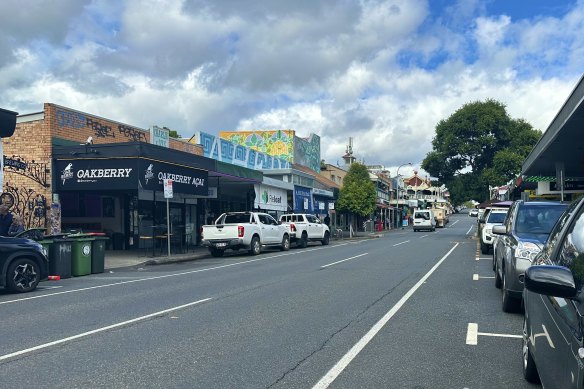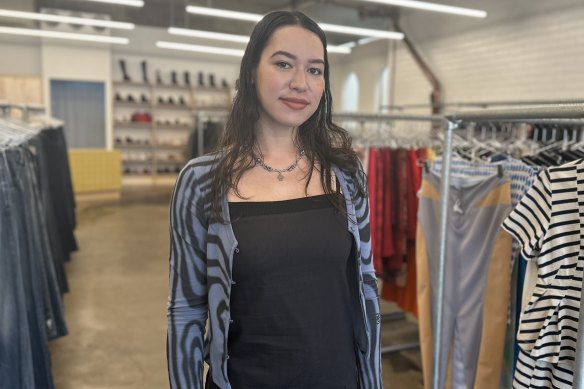This was published 10 months ago
Ditching car parks for bike lanes could help struggling high street shops
Removing kerbside car parks and turning them into cycling lanes could make Brisbane more liveable without hurting small businesses, a researcher argues.
Boundary Street in Brisbane’s eclectic West End was used as a case study by University of Queensland researchers, with Associate Professor Dr Dorina Pojani concluding it would be “appropriate and desirable” to turn at least one on-street parking lane into a bike lane.

Boundary Street in West End has been used in a research project to discover whether removing car parks for a bicycle lane would affect businesses.Credit: Felicity Caldwell
Pojani said contrary to popular perception, the parking occupancy rate on Boundary Street was mostly less than 60 per cent on weekdays.
That was because 42 per cent of visitors walked there.
Of the 214 people surveyed for the project, 40 per cent said they drove or were driven to the area, while 16 per cent cycled or used public transport.
Nearly one-third of private car users travelled less than 3 kilometres to Boundary Street, and more than half travelled less than 10 kilometres – distances that could be travelled by bike.
And almost one in 10 of those who drove there lived in West End.
Pojani said businesses benefited from foot, bike and bus traffic more than cars because of a more frequent flow of customers.
“This is why reassigning parking from one side of the road to a cyclist lane would make better use of that space,” she said, adding they should also be connected to the bike network.
The study, published in Australian Planner, focused on just one street in West End, a suburb with one of the highest rates of active commutes in Brisbane – about 20 per cent.
But Pojani said the findings were relevant elsewhere.
“The ideal solution is to not have on-street parking at all, but instead have multi-storey and underground parking lots, and repurpose kerbside parking space for walking, cycling, scooters and trees,” she said.
“Not only is this better visually, it also improves accessibility and keeps the streets cooler.”
Brisbane Times spoke to visitors and business people on Boundary Street, with most supporting the idea, including Rhianon Ellis, who said West End’s population was “exploding”, and encouraging more people to use active transport would improve congestion.
“People can come and spend their time, they don’t need to worry that they’ve only got half an hour of parking,” she said.

Swop store manager Nicci Dimblon thinks the idea has merit.Credit: Felicity Caldwell
Swop store manager Nicci Dimblon said labelled bike lanes would be a “smart move”.
But one shopkeeper was worried that people would not be able to carry their shopping home by bike, and local Wayne Galvin said even with two lanes of parking, people already found it hard to get a park.
Researchers found drivers and non-drivers spent a similar amount of time on Boundary Street – about two hours on average – but drivers spent about $49 each, walkers $30, public transport users $16 and bike riders $22.
Pojani said previous research showed limiting parking could lead to more people walking, cycling or using public transport, while a study in downtown San Francisco found non-motorists spent more per month than car users because they visited the area more often.
“It is not necessarily the case that drivers have stronger purchasing power; it may simply be that they seek to maximise the return on their less frequent visits to Boundary Street,” she said.
“It is worth noting that larger and/or longitudinal studies have found that bicycle riders spend more over time.”
Pojani said parking should still be provided for people with disabilities.
The research included a public forum with 60 people, surveys of 214 pedestrians, and observations of parking turnover.
Greens councillor Trina Massey said creating pedestrianised, safe streets for active travel was crucial for inner-city suburbs like West End.
“While this study is welcomed, support for this suggestion can’t happen without further in-depth community consultation with residents, community groups, local businesses, and those visiting West End,” she said.
But Massey said walkable, safe, accessible high streets had been shown to drive more foot traffic to small businesses.
A Brisbane City Council spokeswoman said there were no plans to remove kerbside parking on Boundary Street, where there are currently more than 50 car spaces.
“These spaces help ensure local businesses can be accessed by residents who do not live nearby,” she said.
“However, council does consider roads, parking, and kerbside space as part of all planning, along with any relevant research.”